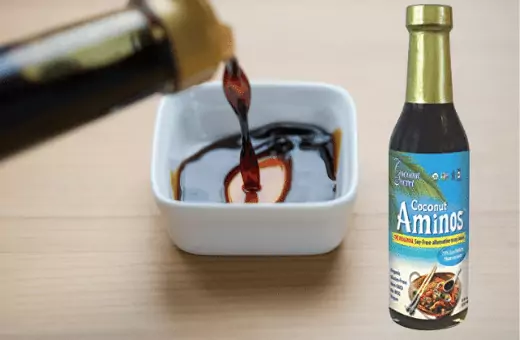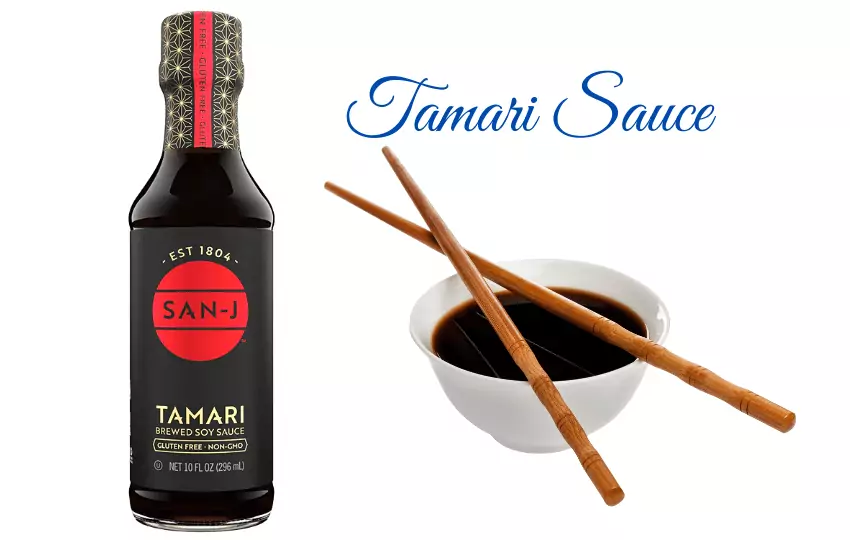If you miss out on your favorite food just for tamari sauce, then don’t worry; here are more than 7 different substitutes listed that can be used instead of tamari and give you that unforgettable taste.
All of the versatile magical sauce really is-so go ahead try them out today!.
What is in Tamari Sauce?
Tamari sauce is a traditional Asian sauce made with soybeans, salt, and water (traditionally, rice koji was used in combination).
Tamari is different from regular soy sauce in that it is made with little or no wheat. This makes tamari preferable for those avoiding gluten.
The most common type of tamari, shoyu tamari, comes from Japan and has a high concentration of soybeans and little wheat.
Its flavor is richer than conventional soy sauce, with a very distinct taste of the soybean.
Tamari has more body than regular soy sauce and adds more saltiness to foods. It is made with less liquid than conventional soy sauce.
Tamari VS Soy Sauce: What’s the Difference?
How will you know which one is better for your health and your taste buds? Well, we’re here to help you figure it out.
Soy sauce has been around for a longer period of time than tamari. The two condiments actually have similarities since they both originate from Japan.
They are both made from soybeans, wheat, and salt. However, tamari has a slightly different flavor because of the fermentation process.
1. Tamari undergoes a long fermentation process that lasts up to six months. The fermentation process creates a deeper and richer flavor than soy sauce. In contrast, soy sauce goes through a shorter fermentation process, which results in a lighter flavor.
2. Tamari also contains more minerals and vitamins than soy sauce. It is higher in B vitamins, zinc, and magnesium.
3. Tamari contains lower sodium than soy sauce.
4. Tamari is a better choice than soy sauce for people who are looking for a condiment with a richer flavor and more nutrients.
5. Soy sauce is a better choice than tamari for people who are looking for a condiment with a lighter flavor.
Meanwhile, you wonder! Is tamari better than soy sauce?
I guess, Yes It is but a choice according to your preferences and recipes.
Now, let’s move on to some Tamari sauce alternatives, which are easy to find out and reliable. I also include some vegan and vegetarian-friendly replacements. So keep reading.
7 Tamari Substitutes
There are a few Tamari substitutes on the market. One is coconut aminos, Braggs liquid aminos, gluten-free Tamari substitutes available.
These substitutes typically have a more pronounced salty flavor than regular Tamari. Whichever replacement you choose, make sure to read the label to ensure that it does not contain any gluten.
1. COCONUT AMINOS- Best alternative who has Soy allergy
Coconut aminos are derived from the sap of coconut blooms. It has a slightly sweet and smoky taste, making it a good substitute for Tamari.

Coconut Secret Coconut Aminos is made from organic whole sun-ripened coconuts tree sap (not from the coconut palm), which has been aged and blended with sea salt to create a rich, healthy, and gourmet taste.
Coconut Aminos has no additives, and it is naturally fermented, so there’s no need to add any preservatives such as MSG or other weird stuff.
Hence, this healthier soy-free version of Tamari sauce is suitable for people who want to avoid wheat, gluten, and soy which is perfect for vegans and vegetarians.
Read More– 16 Genuine ALternavtives to Coconut Sugar
2. BRAGGS LIQUID AMINOS
Another option is Braggs liquid aminos, which is made from soybeans and has a savory flavor.
This stuff has a great taste and is saltier than soy sauce, so you can use less.
Braggs liquid amino also contains the same amount of sodium as soy sauce but are much healthier for you with none of the anti-nutrients found in soy.
I sometimes sprinkle this on my salads instead of dressing, which makes me crave salad more often, too!
This is available at Whole Foods or any health food store. Try to avoid those sketchy Asian markets because they usually have MSG in their products if they aren’t explicitly labeled as vegan.
You can add to stir-fries, rice, and even salad dressings.
3. Gluten-free Tamari Substitute
For diet, conscious people, don’t worry; you also have the option to choose an alternative ingredient for Tamari sauce.
Gluten-free Tamari substitutes are available. These substitutes typically have a more pronounced salty flavor than regular Tamari.
If you cannot find tamari sauce, you can make your own gluten-free soy sauce substitute by combining.
· 1/2 cup vegetable broth,
· 1/4 cup rice vinegar,
· 2 tablespoons honey,
· 2 teaspoons gluten-free tamari sauce, and
· 1 teaspoon sesame oil in a blender.
Blend until the mixture is smooth. Fridge the mix in a tightly covered container for up to two weeks.
4. FISH SAUCE
Fish sauce is a condiment famous in Southeast Asian cuisine. You can use fish sauce as a substitute for tamari sauce in a recipe.

First, determine the amount of fish sauce needed by substituting it ounce-for-ounce for tamari sauce.
Then, add it to the recipe according to the directions. Keep in mind that fish sauce is salty, so use sparingly at first until you get a feel for how much you need.
Additionally, fish sauce has a strong flavor, so it might not suit all recipes. Try it out in some simple dishes before using it in more complex recipes.
Here are some tips for using fish sauce:
– The fish sauce is very salty, so start with a little and add more as needed.
– The fish sauce has a strong flavor, so it might not be suitable for all recipes. Try it out in some simple dishes before using it in more complex recipes.
– The fish sauce can be used as a substitute for tamari sauce in a recipe. Substitute ounce-for-ounce to determine the amount of fish sauce needed.
5. SOY SAUCE
Different types of soy sauce, such as tamari and soy sauce, can be used interchangeably in recipes.
Tamari is made from wheat and soybeans, while soy sauce is a blend of fermented soybeans and wheat. However, tamari contains less sodium than soy sauce and has a slightly different flavor.
When substituting soy sauce for tamari, it is essential to use the exact volume measurement. Just like, if a recipe calls for 1 tablespoon of tamari sauce, use 1 tablespoon of soy sauce instead.
If you are using dark soy sauce instead of another type of soy sauce, such as light soy sauce, you may need to adjust the amount depending on the recipe.
6. BALSAMIC VINEGAR
Balsamic vinegar is an excellent option as an alternative ingredient. It has a slightly sweet and tart flavor that can work well in many dishes.
Here are some ideas for how to use balsamic vinegar in your cooking:
-Balsamic vinegar can be used as a marinade for meat or fish. It will flavor the meat and tenderize it.
-It can also be used as a salad dressing. Combine it with olive oil, honey, and Dijon mustard for a primary dressing, or be creative and create your own.
-In addition to salads, balsamic vinegar can be added to roasted vegetables or pasta dishes. It will provide them with a distinct flavor that will set them apart from the other elements.
-For a sweet and tangy finish, add a few tablespoons of balsamic vinegar to your favorite fruit salad.
Balsamic vinegar is a great substitute for tamari sauce in many recipes with its diverse flavor profile. Try it someday the next time you’re in the mood to try something new in the kitchen!
If you don’t like or can’t find any of these ingredients, make our own easy-to-make homemade tamari sauce, which is the same as store-brought tamari sauce.
7. HOMEMADE TAMARI SAUCE
Ingredients:
· 1 cup soy sauce
· 2 tablespoons rice vinegar
· 2 tablespoons honey
· 1 teaspoon sesame oil
· 1 clove garlic, minced
· 1/4 teaspoon ground ginger
Instructions:
1. Take a small saucepan over medium heat, combine all of the ingredients.
2. Bring to a simmer and cook until slightly thickened, about 5 minutes.
3. Serve warm or cold.
Refrigerate in an airtight container for up to 2 weeks.
Making your own tamari sauce is easy and much cheaper than buying it at the store. This version is made with soy sauce, rice vinegar, honey, and sesame oil. It’s delicious on grilled meat or fish, or even as a dipping sauce for chicken.
Wind Up – Substitute for Tamari Sauce
Which ingredient do you prefer, and which is left over? Please let me know.
Tamari is a special kind of sauce that makes a recipe for Authentic Japanese spark. Although, you can get a similar taste after using such alternatives.
FAQs Related to Tamari Sauce & Its alternatives
Q1. Can I use Worcestershire sauce instead of tamari?
Yes, Worcestershire sauce can be used to substitute for tamari in most recipes.
However, it is slightly sweeter than tamari, so you may need to adjust the amount of sugar or other sweeteners in the recipe.
Additionally, Worcestershire sauce contains anchovies, so it may not be suitable for people who are allergic to seafood.
Tamari is a gluten-free soy sauce prepared without wheat. If you are gluten-free, be sure to use tamari in recipes that call for soy sauce.
Q2. Can I substitute dark soy sauce for tamari?
There is no absolute explanation to this question as tamari and dark soy sauce are both made from soybeans, but they are produced differently.
Tamari is a soy sauce prepared without wheat., while dark soy sauce includes wheat in its production.
As a result, tamari will generally have a slightly sweeter and less salty taste than dark soy sauce.
Finally, the type of soy sauce you use in your cuisine is a matter of personal preference.

